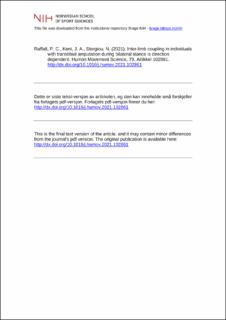| dc.contributor.author | Raffalt, Peter Christian | |
| dc.contributor.author | Kent, Jenny A. | |
| dc.contributor.author | Stergiou, Nicholas | |
| dc.date.accessioned | 2023-10-25T07:02:09Z | |
| dc.date.available | 2023-10-25T07:02:09Z | |
| dc.date.created | 2021-09-07T13:40:13Z | |
| dc.date.issued | 2021 | |
| dc.identifier.citation | Human Movement Science. 2021, 79(October 2021), Artikkel 102861. | en_US |
| dc.identifier.issn | 0167-9457 | |
| dc.identifier.uri | https://hdl.handle.net/11250/3098561 | |
| dc.description | I Brage finner du siste tekst-versjon av artikkelen, og den kan inneholde ubetydelige forskjeller fra forlagets pdf-versjon. Forlagets pdf-versjon finner du på sciencedirect.com / In Brage you'll find the final text version of the article, and it may contain insignificant differences from the journal's pdf version. The definitive version is available at sciencedirect.com | en_US |
| dc.description.abstract | We investigated the control of upright standing in individuals with unilateral transtibial amputation (TTA) by assessing the inter-limb coupling and the coupling between the center of pressure beneath both limbs combined (COPNET) and the center of pressure (COP) beneath the prosthetic limb and the intact limb. Twenty-one adults with TTA and eighteen unimpaired adults completed 90 s of standing on two parallel force plates. The inter-limb coupling and the coupling between the COP beneath each limb and the COPNET were assessed by quantifying the synchronization of the COP signals. This included the number of epochs with synchronized signals, the total duration of signal synchronization and the relative phase and deviation phase between the signals. Additionally, magnitude and temporal characteristics of the COP displacements were quantified. Individuals with TTA exhibited looser inter-limb coupling in the anterior-posterior direction, characterized by more shifts between epochs with synchronized signals, shorter total duration of signal synchronization, less in-phase coordination patterns and a higher deviation phase between the two limbs, compared to unimpaired individuals. This coincided with a larger and more irregular postural sway in the TTA group. No group difference was observed in the mediolateral direction. The coupling between the COPNET and the COP beneath the individual limbs was similarly direction dependent, and tighter for the intact side, suggesting that an intact limb-driven strategy was utilized. | en_US |
| dc.language.iso | eng | en_US |
| dc.subject | prosthesis | en_US |
| dc.subject | phase synchronization | en_US |
| dc.subject | postural control | en_US |
| dc.subject | center of pressure dynamics | en_US |
| dc.title | Inter-limb coupling in individuals with transtibial amputation during bilateral stance is direction dependent | en_US |
| dc.title.alternative | Inter-limb coupling in individuals with transtibial amputation during bilateral stance is direction dependent | en_US |
| dc.type | Peer reviewed | en_US |
| dc.type | Journal article | en_US |
| dc.description.version | acceptedVersion | en_US |
| dc.source.pagenumber | 12 | en_US |
| dc.source.volume | 79 | en_US |
| dc.source.journal | Human Movement Science | en_US |
| dc.identifier.doi | 10.1016/j.humov.2021.102861 | |
| dc.identifier.cristin | 1932060 | |
| dc.description.localcode | Institutt for fysisk prestasjonsevne / Department of Physical Performance | en_US |
| cristin.ispublished | true | |
| cristin.fulltext | postprint | |
| cristin.qualitycode | 1 | |
